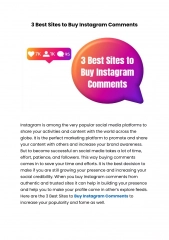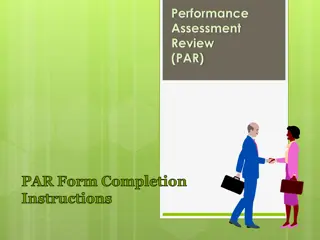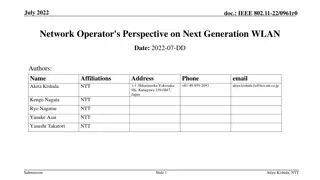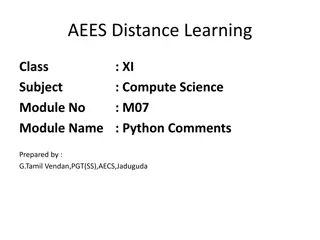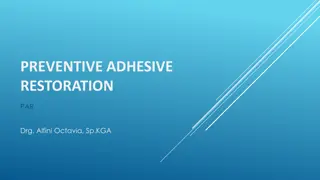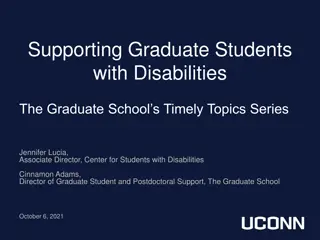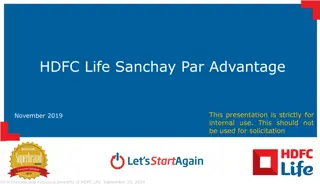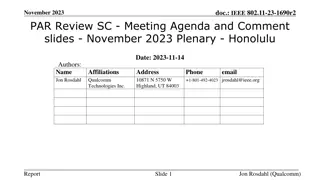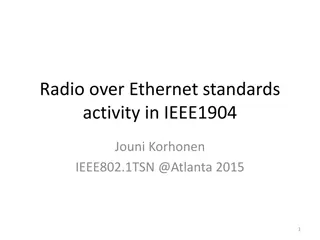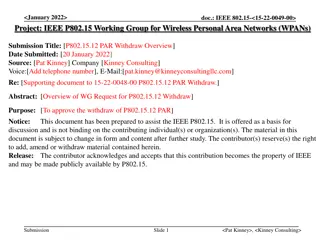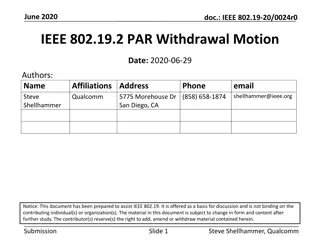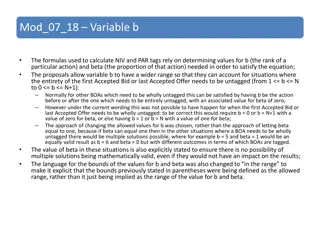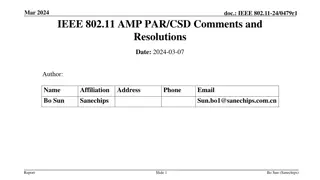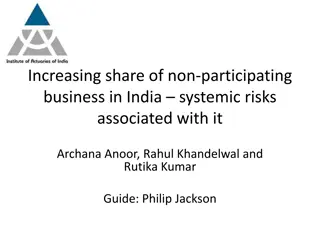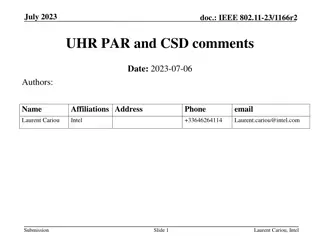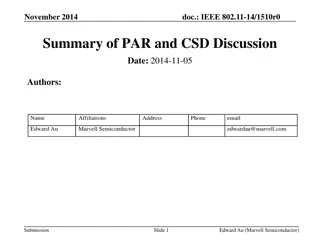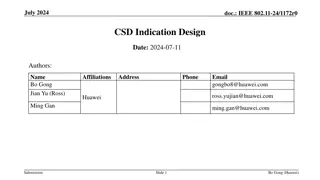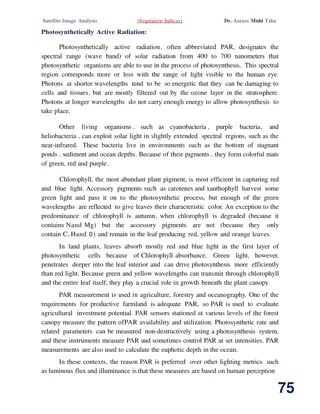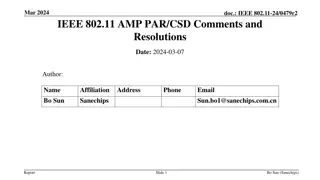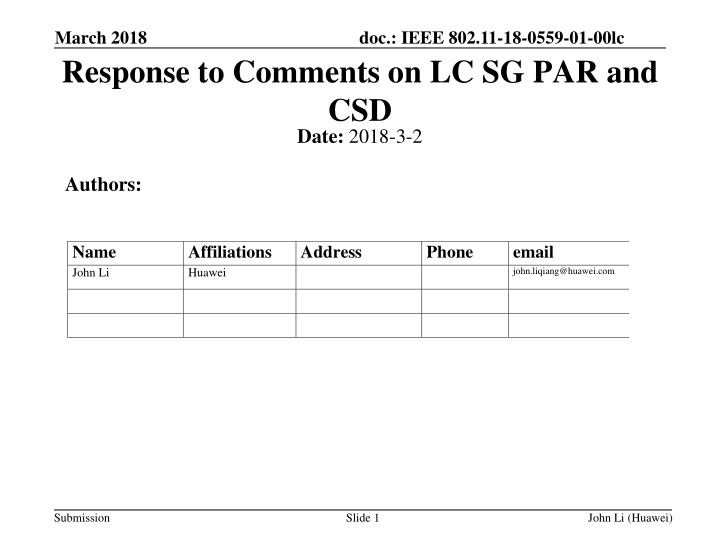
March 2018 Response to Comments on LC SG PAR and CSD
This document discusses comments on the LC SG PAR and CSD, along with responses from the LC SG members. It covers feedback from individuals like Bob Grow, James Gilb, and Paul Nikolich regarding draft PAR and CSD documents, with a focus on addressing observed inconsistencies and justifying project needs. Responses and resolutions to comments are provided, aiming to meet the submission deadline. Explore the detailed responses and resolutions to enhance your understanding of the discussions.
Download Presentation

Please find below an Image/Link to download the presentation.
The content on the website is provided AS IS for your information and personal use only. It may not be sold, licensed, or shared on other websites without obtaining consent from the author. If you encounter any issues during the download, it is possible that the publisher has removed the file from their server.
You are allowed to download the files provided on this website for personal or commercial use, subject to the condition that they are used lawfully. All files are the property of their respective owners.
The content on the website is provided AS IS for your information and personal use only. It may not be sold, licensed, or shared on other websites without obtaining consent from the author.
E N D
Presentation Transcript
March 2018 Response to Comments on LC SG PAR and CSD Date: 2018-3-2 doc.: IEEE 802.11-18-0559-01-00lc Authors: Name John Li Affiliations Huawei Address Phone email john.liqiang@huawei.com Submission Slide 1 John Li (Huawei)
March 2018 doc.: IEEE 802.11-18-0559-01-00lc Abstract This slide deck documents the comments on LC SG PAR and CSD, and the corresponding response from LC SG. Submission Slide 2 John Li (Huawei)
March 2018 doc.: IEEE 802.11-18-0559-01-00lc Introduction Comments against draft PAR in doc. 11-17/1604r8 and draft CSD in doc. 11-17/1603r7 are received from Bob Grow (treated during Feb conference call) James Gilb Paul Nikolich IEEE 802.3 The SG is expected to provide responses to the received comments before 6:30 PM Wednesday (March 7th) Submission Slide 3 John Li (Huawei)
March 2018 doc.: IEEE 802.11-18-0559-01-00lc Response to comments from Bob Grow - treated during Feb conference call - resolutions can be found at https://mentor.ieee.org/802.11/dcn/18/11-18-0387-01-00lc-lc- par-csd-comments.xls - Comment and resolutions are reproduced in the following pages Submission Slide 4 John Li (Huawei)
March 2018 doc.: IEEE 802.11-18-0559-01-00lc Comments from Bob Grow on PAR Comment: General. Because of observed inconsistencies, it appears that this PAR was not generated on the myProject system. The myProject system should be used. It provides easy access to instructions, assures use of current forms (simplifying review) and minimizes entry errors after 802 approval. Response: myProject will used by Li Qiang (John) and Jon Rosdahl as editors for the final PAR document Submission Slide 5 John Li (Huawei)
March 2018 doc.: IEEE 802.11-18-0559-01-00lc Comments from Bob Grow on PAR Comment: 5.5. This need statement mostly expresses a technology push based project, not a market demand justified project. The increase in availability of unlicensed spectrum provided by light covered in the Broad Market Potential is better at justifying from a market side than does this need statement. Response: Changing the following sentence: The wider context for the economic considerations for LC is presented in doc. 11-17/0803r1 (https://mentor.ieee.org/802.11/dcn/17/11-17-0803-01-00lc- economic-considerations-for-lc.ppt) To The wider context for the economic considerations like decreasing costs for LEDs/LDs and the availability of higher frequency spectrum for LC is presented in doc. 11-17/0803r1 (https://mentor.ieee.org/802.11/dcn/17/11-17-0803-01- Submission 00lc-economic-considerations-for-lc.ppt). Slide 6 John Li (Huawei)
March 2018 doc.: IEEE 802.11-18-0559-01-00lc Comments from Bob Grow on PAR Comment: 5.6. So a company that views itself as an established IoT company isn t a stakeholder? A small or medium sized industrial manufacturer isn t a stake holder? Response: Revised. Delete "emerging" and "large". New text to read: "Stakeholders include chip makers to deliver PHY & MAC sub- systems, system integrators and lighting companies, telecom operators, Internet Service Providers (ISPs), IoT companies, industrial manufacturers, aviation and transportation industries." Submission Slide 7 John Li (Huawei)
March 2018 doc.: IEEE 802.11-18-0559-01-00lc Comments from Bob Grow on PAR Comment: 5.5 The stakeholder list does not agree with the CSD Broad Market Potential answer. The Broad Market answer basically says light communications is applicable everywhere existing radio PHY wireless LANs are used. Response: The set of stakeholders in the updated PAR and CSD are now consistent The "Broad Market Potential" Section 1.2.1 (a) looks at the "Broad set of applicability" that aims to identify the possible use-cases for the technology. Submission Slide 8 John Li (Huawei)
March 2018 doc.: IEEE 802.11-18-0559-01-00lc Comments from Bob Grow on PAR Comment: 6.1.b Had the PAR been prepared on myProject, the person preparing the PAR would know that an explanation is required for a yes answer. Is a new registry being proposed? Is the amendment expected to produce new text with registry related content? (If so, what registry?) If the amendment will only be using existing capabilities (e.g., using and not modifying existing specifications for transmission of frames, and not changing or adding specifications for what addresses are used in those frames) then that is not a registry activity. Response: Revised. Include in Section 6.1.b : "Project may define new Management frames (extending the existing 802.11 frame structure) to support its new features. These frames will include fields that contain 48-bit MAC addresses. It is not expected that any new namespaces for allocation under RAC control will be defined." Slide 9 Submission John Li (Huawei)
March 2018 doc.: IEEE 802.11-18-0559-01-00lc Comments from Bob Grow on PAR Comment: 7.1. Had the PAR been prepared on myProject, the person preparing the PAR would know that an explanation is required. Why an additional standard is needed for a yes answer, not just a list of the similar scope standards. The PAR form instruction reads: "Identify any standard(s) or project(s) of similar scope(s), both within or outside of the IEEE, and explain the need for an additional standard in this area. Response: Revise PAR (doc. 11-17/1604r8) Section 7.1 to include the explanation from the CSD (doc. 11-17/1603r7) Section 1.2.3, which reads: "The difference between LC and the existing IEEE 802 light based communication standards is the use of the IEEE 802.11 MAC as well as the reuse of associated services. This new approach will allow LC to address a wider range of use cases that are served by local wireless area networks compared to the existing (IEEE P802.15.7m and IEEE P802.15.13) efforts that are focusing on deploying the technology for optical camera communications, low data rate photodiode communications, and industrial applications. The key difference between the ITU-T G.vlc effort compared to the proposed IEEE 802.11 LC amendment is the use of the IEEE 802.11 MAC as well as the targeted deployment of the technology in wider range of use cases including electromagnetic interference (EMI) sensitive environments, in contrast to the focused home networking use-case for the G.vlc technology. Critically, being part of the IEEE 802.11 ecosystem enables LC to leverage the existing brand awareness and processes for product development, testing and market introduction. Tight integration with IEEE 802.11, the coexistence and hand-over with other IEEE 802.11 PHY types (through the use of Fast-Session Transfer) will help to increase the LC market by addressing large volume applications together with traditional lighting." Slide 10 Submission John Li (Huawei)
March 2018 doc.: IEEE 802.11-18-0559-01-00lc Response to comments from James Gilb Submission Slide 11 John Li (Huawei)
March 2018 doc.: IEEE 802.11-18-0559-01-00lc Comments from James Gilb on PAR Comment: 5.2.b Scope of the project The scope should state if this is free space or fiber communications Response: Accept. Revised text: This amendment specifies a new physical (PHY) layer and modifications to the IEEE 802.11 medium access control (MAC) that enable operation of wireless light communications (LC). Submission Slide 12 John Li (Huawei)
March 2018 doc.: IEEE 802.11-18-0559-01-00lc Comments from James Gilb on PAR Comment: 5.2.b Scope of the project The scope should state the target distance for the links. If there is a range of distances, list them. Response: Revise, the description of range of distances is inserted in CSD 1.2.4 as follows: The distance of LC link varies from tens of meters for indoor operations to hundreds of meters for outdoor operations depending on the use cases. Submission Slide 13 John Li (Huawei)
March 2018 doc.: IEEE 802.11-18-0559-01-00lc Comments from James Gilb on PAR Comment: 5.2.b Scope of the project "coexistance", should be "coexistence" Response: Accept. Revised text: Overlapping basic service set (OBSS) detection and coexistance coexistence Submission Slide 14 John Li (Huawei)
March 2018 doc.: IEEE 802.11-18-0559-01-00lc Comments from James Gilb on PAR Comment: 5.4 Purpose I believe the correct response here is "This amendment will not have a purpose clause." instead of the text "This amendment does not change the Purpose clause of IEEE 802.11" Response: Accept Submission Slide 15 John Li (Huawei)
March 2018 doc.: IEEE 802.11-18-0559-01-00lc Comments from James Gilb on PAR Comment: 5.5 Need for the project Delete "significant" Response: Accept, delete the first instance 5.5 Need for the Project: A significant variety of LC vendors currently build various, non-standardized, products for many use- cases that could have significant market growth. Submission Slide 16 John Li (Huawei)
March 2018 doc.: IEEE 802.11-18-0559-01-00lc Comments from James Gilb on PAR Comment: 6.1.b If the answer here is yes, you need to provide an explanation. Response: Revised. Include in Section 6.1.b : "Project may define new Management frames (extending the existing 802.11 frame structure) to support its new features. These frames will include fields that contain 48-bit MAC addresses. It is not expected that any new namespaces for allocation under RAC control will be defined." Submission Slide 17 John Li (Huawei)
March 2018 doc.: IEEE 802.11-18-0559-01-00lc Comments from James Gilb on PAR Comment: 7.1 Verify that the titles of the 802.15 standards are correct. They seem to be incorrect. Response: Accept: revise to Project Title: Part 15.7 Revision: Short-Range Optical Wireless Communications IEEE P802.15.7 Standard for Short-Range Wireless Optical Communication Project Title: Part 15.13: Standard for Multi-Gigabit per Second Optical Wireless Communications (OWC) with Ranges up to 200 meters IEEE P802.15.13 Standard for Multi-Gigabit per Second Optical Wireless Communications (OWC) with Ranges up to 200 meters Slide 18 Submission John Li (Huawei)
March 2018 doc.: IEEE 802.11-18-0559-01-00lc Comments from James Gilb on PAR Comment: 8.1 "Requitements" should be "Requirements Response: Accept Submission Slide 19 John Li (Huawei)
March 2018 doc.: IEEE 802.11-18-0559-01-00lc Comments from James Gilb on CSD Comment: 1.2.1 Spell out IR Response: Accept The light spectrum, for the most part, has been underutilised for free space communication. Both the visible light spectrum and the IR infrared (IR) spectrum are unlicensed and could be used primarily in short-range wireless scenarios. In addition, the use of light for communications also supports the increasingly dense deployment of smaller and smaller cells. Submission Slide 20 John Li (Huawei)
March 2018 doc.: IEEE 802.11-18-0559-01-00lc Comments from James Gilb on CSD Comment 1.2.1 "IEEE P802.11aj and P802.11ay" should be "IEEE Std 802.11aj and IEEE P802.11ay Response Accept Submission Slide 21 John Li (Huawei)
March 2018 doc.: IEEE 802.11-18-0559-01-00lc Comments from James Gilb on CSD Comment 1.2.1 underutilised" should be "underutilized Response Accept Submission Slide 22 John Li (Huawei)
March 2018 doc.: IEEE 802.11-18-0559-01-00lc Comments from James Gilb on CSD Comment 1.2.1 Missing blank line after first paragraph in b) and extra blank lines at the end of the subsection Response Accept Submission Slide 23 John Li (Huawei)
March 2018 doc.: IEEE 802.11-18-0559-01-00lc Comments from James Gilb on CSD Comment 1.2.3 Add "IEEE" in front of 802. (line 21) Add "IEEE" in front of 802.11 (5 locations) Add "IEEE" in front of 802.15 (2 locations) Response Accept, in addition, add P in front of 802.15.7m and 802.15.13 Submission Slide 24 John Li (Huawei)
March 2018 doc.: IEEE 802.11-18-0559-01-00lc Comments from James Gilb on CSD Comment 1.2.4: The purpose of the CSD is to enable the reviewer to evaluate the proposed project. Placing a significant amount of the content in external documents is not responsive to the question. Provide a short list of the work that demonstrates the hardware feasibility and then point to a document for more information. Response Revise, the revised text is The LC-TIG report provides a list of publications and examples of hardware feasibility of LC. The LC-TIG report can be found at https://mentor.ieee.org/802.11/dcn/17/11-17-0023-09-00lc-lc-tig- draft-report-outline.docx. Submission Slide 25 John Li (Huawei)
March 2018 doc.: IEEE 802.11-18-0559-01-00lc Comments from James Gilb on CSD Comment 1.2.4 Delete "significant" in "significant variety Response Accept Submission Slide 26 John Li (Huawei)
March 2018 doc.: IEEE 802.11-18-0559-01-00lc Comments from James Gilb on CSD Comment 1.2.4: In b), the existence of the mature 802.11 technology is not relevant to this project. You are supposed to answer regarding the proposed addition, which has not been tested. Focus here on listing similar technology in this section, e.g., LC type devices, that already exist. Again, placing essentially all of the content in an external document is not helpful. Delete "The amendment will use modeling and simulation as tools for evaluating performance metrics." The question is asking if there is _currently_ simulation and modeling to support technical feasibility. Submission Slide 27 John Li (Huawei)
March 2018 doc.: IEEE 802.11-18-0559-01-00lc Comments from James Gilb on CSD Response Delete presentent in 1.2.1 (b) Spell out LED in 1.2.1 (b) Revise the first paragraph of 1.2.4(b) into Wireless communication using infrared band is a proven commercialized technology. These principles can be directly extended to visible light band using LED which are also used for illumination. The technology has been thoroughly studied using modeling and simulations in literature. A variety of LC vendors currently build various, non-standardized, products. An example list of these products can be found in the LC-TIG report Delete "The amendment will use modeling and simulation as tools for evaluating performance metrics." Submission Slide 28 John Li (Huawei)
March 2018 doc.: IEEE 802.11-18-0559-01-00lc Comments from James Gilb on CSD Comment 1.2.5 Missing line after first paragraph in a) Change "emoding" to be "implementing" Missing line after first paragraph in b) Missing line after first paragraph in d) Extra blank lines at the end. o Delete all of the text following e). Answering e) is optional (answering any of a-d is optional as well). Also, the text does not address economic feasibility. Response Accept, in addition, systematically check whether the standard/project index are correctly formulated. Submission Slide 29 John Li (Huawei)
March 2018 doc.: IEEE 802.11-18-0559-01-00lc Comment from Paul Nikolich Submission Slide 30 John Li (Huawei)
March 2018 doc.: IEEE 802.11-18-0559-01-00lc Comment from Paul Nikolich on PAR Comment 1) in 2.1 Title: change "light communications" to "light wave operation". Rationale: "Light Communications" is too broad for use in the title (LC is used in a wide variety of ways in the PAR and CSD, e.g. LC PHY, LC devices, LC vendor, LC systems, LC market, etc.). "Light wave operation" better reflects (what I perceive) to be the principle objective of the project -- specifying an 802.11 standard amendment defining operation over light wave carrier frequencies. Please consider making the change in the Title, and only in the Title. I believe the remainder of "light communication" and "LC" instances do not need change or be modified. Response The LC SG evaluated your option to make a change to the title along with the subsequent changes that would be required to make that change, and determined to maintain the existing title, see straw poll on slide18 in doc.11-18/315r2. This amendment is to the Wireless LAN standard and thus wireless operation is indicated Submission Slide 31 John Li (Huawei)
March 2018 doc.: IEEE 802.11-18-0559-01-00lc Comment from 802.3 Submission Slide 32 John Li (Huawei)
March 2018 doc.: IEEE 802.11-18-0559-01-00lc Comments from 802.3 on PAR Comment General Because of observed inconsistencies, it appears that this PAR was not generated on the myProject system. Thank you for the preview of a myProject version, some comments may highlight things corrected in that myProject version. Response: myProject will be used by Li Qiang (John) and Jon Rosdahl as editors for the final PAR document Submission Slide 33 John Li (Huawei)
March 2018 doc.: IEEE 802.11-18-0559-01-00lc Comments from 802.3 on PAR Comment: 5.5 This need statement mostly expresses a technology push based project, not a market demand justified project. The increase in availability of unlicensed spectrum provided by light covered in the Broad Market Potential is better at justifying from a market side than does this need statement. Please improve to describe market demand. Response: Changing the following sentence: The wider context for the economic considerations for LC is presented in doc. 11- 17/0803r1 (https://mentor.ieee.org/802.11/dcn/17/11-17-0803-01-00lc-economic- considerations-for-lc.ppt) To The wider context for the economic considerations like decreasing costs for LEDs/LDs and the availability of unregulated light spectrum for LC is presented in doc. 11- 17/0803r1 (https://mentor.ieee.org/802.11/dcn/17/11-17-0803-01-00lc-economic- considerations-for-lc.ppt). Submission Slide 34 John Li (Huawei)
March 2018 doc.: IEEE 802.11-18-0559-01-00lc Comments from 802.3 on PAR Comment 5.6 So a company that views itself as an established IoT company isn t a stakeholder? A small or medium sized industrial manufacturer isn t a stake holder? Delete established , large . Response: Revised. Delete "emerging" and "large". New text to read: "Stakeholders include chip makers to deliver PHY & MAC sub- systems, system integrators and lighting companies, telecom operators, Internet Service Providers (ISPs), IoT companies, industrial manufacturers, aviation and transportation industries." Submission Slide 35 John Li (Huawei)
March 2018 doc.: IEEE 802.11-18-0559-01-00lc Comments from 802.3 on PAR Comment: The stakeholder list does not agree with the CSD Broad Market Potential answer. The Broad Market answer basically says light communications is applicable everywhere existing radio PHY wireless LANs are used. Please make the documents consistent. Response: The set of stakeholders in the updated PAR and CSD are now consistent The "Broad Market Potential" Section 1.2.1 (a) looks at the "Broad set of applicability" that aims to identify the possible use-cases for the technology. Submission Slide 36 John Li (Huawei)
March 2018 doc.: IEEE 802.11-18-0559-01-00lc Comments from 802.3 on PAR Comment: Had the PAR been prepared on myProject, the person preparing the PAR would know that an explanation is required. Why an additional standard is needed for a yes answer, not just a list of the similar scope standards. The PAR form instruction reads: Identify any standard(s) or project(s) of similar scope(s), both within or outside of the IEEE, and explain the need for an additional standard in this area. Response: see next page Submission Slide 37 John Li (Huawei)
March 2018 doc.: IEEE 802.11-18-0559-01-00lc Comments from 802.3 on PAR Response 7.1 Revise PAR (doc. 11-17/1604r8) Section 7.1 to include the explanation from the CSD (doc. 11- 17/1603r7) Section 1.2.3, which reads: "The difference between LC and the existing IEEE 802 light based communication standards is the use of the IEEE 802.11 MAC as well as the reuse of associated services. This new approach will allow LC to address a wider range of use cases that are served by local wireless area networks compared to the existing (IEEE P802.15.7m and IEEE P802.15.13) efforts that are focusing on deploying the technology for optical camera communications, low data rate photodiode communications, and industrial applications. The key difference between the ITU-T G.vlc effort compared to the proposed IEEE 802.11 LC amendment is the use of the IEEE 802.11 MAC as well as the targeted deployment of the technology in wider range of use cases including electromagnetic interference (EMI) sensitive environments, in contrast to the focused home networking use-case for the G.vlc technology. Critically, being part of the IEEE 802.11 ecosystem enables LC to leverage the existing brand awareness and processes for product development, testing and market introduction. Tight integration with IEEE 802.11, the coexistence and hand-over with other IEEE 802.11 PHY types (through the use of Fast-Session Transfer) will help to increase the LC market by addressing large volume applications together with traditional lighting." Submission Slide 38 John Li (Huawei)

